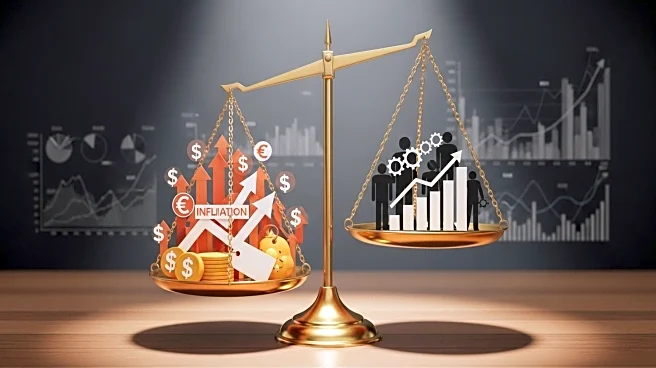What's Happening?
The MSCI global equities gauge experienced a decline, while U.S. Treasury yields rose following the release of unexpectedly strong economic data. The U.S. economy's growth rate for the second quarter was revised upward to 3.8% from an initial 3.3%, driven by increased consumer spending and reduced imports. Additionally, new orders for U.S.-manufactured capital goods rose in August, although shipments declined, indicating moderate growth in business equipment spending. The Labor Department reported a decrease in unemployment claims, with 218,000 new applications filed, surpassing expectations. These developments have led to concerns that the Federal Reserve may be less inclined to cut interest rates further, despite recent reductions. Fed officials expressed mixed views, with some supporting further rate cuts and others cautioning against them due to inflation concerns.
Why It's Important?
The strong economic data has significant implications for U.S. monetary policy and financial markets. If the Federal Reserve decides to hold off on further rate cuts, it could impact borrowing costs and investment strategies across various sectors. Higher interest rates may slow economic growth, affecting consumer spending and business investments. Conversely, maintaining or increasing rates could stabilize inflation but may also lead to increased volatility in stock markets. Investors and businesses are closely monitoring the Fed's decisions, as they will influence economic conditions and financial planning. The mixed signals from Fed officials add uncertainty to the economic outlook, potentially affecting market confidence and investment flows.
What's Next?
The Federal Reserve's upcoming meetings will be crucial in determining the direction of interest rates. Stakeholders, including businesses and investors, will be watching for any indications of policy shifts. The Fed's decision will likely depend on further economic data and inflation trends. Market participants may adjust their strategies based on anticipated rate changes, impacting stock and bond markets. Additionally, global economic conditions and geopolitical factors could influence the Fed's decisions, adding complexity to the economic landscape. The ongoing debate among Fed officials suggests that future rate cuts are possible but not guaranteed, leaving room for market speculation.
Beyond the Headlines
The current economic situation highlights the delicate balance the Federal Reserve must maintain between supporting growth and controlling inflation. The mixed economic signals underscore the challenges of monetary policy in a dynamic global environment. The Fed's actions will have long-term implications for economic stability and growth, influencing consumer confidence and business investments. The evolving economic landscape may also prompt discussions on fiscal policy measures to complement monetary efforts. As the U.S. economy navigates these complexities, stakeholders must remain adaptable to changing conditions and potential policy shifts.











